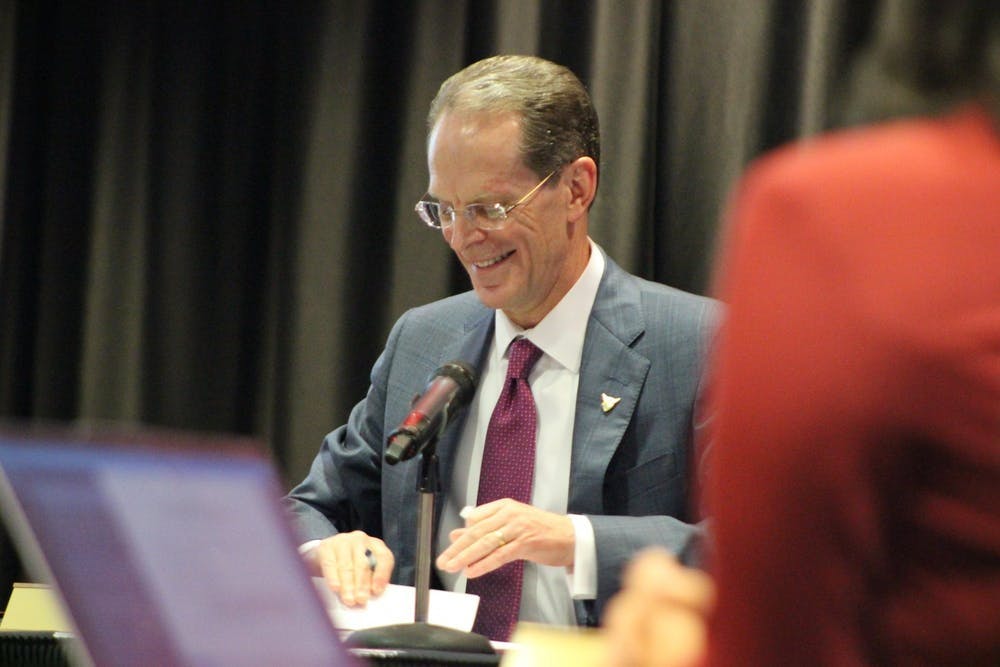What is a line of credit?
A line of credit is given by a bank to an individual or business, similar to a loan, but the borrower only pays interest on the funds they use. A loan requires immediate payment of interest, while a line of credit provides a borrowing limit and only requires interest payment on the funds a borrower uses.
Source: Credit Karma
Ball State's Board of Trustees approved the university to take out its first line of credit to prepare for financial uncertainty amid the COVID-19 pandemic.
The line of credit will be provided by First Merchants Bank, said Mark Hardwick, member of the Board of Trustees. Hardwick, who works as the executive vice president, CFO and COO of First Merchants Corporation, recused himself from voting on the approval.
Alan Finn, Ball State’s vice president for business affairs and treasurer, said it is important for the university to have a line of credit available should it be needed.
“I’ve had a line of credit available at every other institution that I’ve been at, just to provide a short-term funding mechanism,” Finn said. “With the uncertainty in the financial markets because of the current crisis, we decided to look at 11 banks at perhaps getting a line of credit.”
Out of the different options, he said First Merchants Bank provided the best line of credit with the cheapest interest rate. He hopes Ball State is offered a $30 million line of credit with the opportunity to borrow more if needed.
“Depending on the situation, if things get worse than we think they are going to or something happens in the markets, we would have the opportunity to go into this line of credit rather than selling what may be our undervalued bonds that might be returning to a higher interest rate,” Finn said.
The Board unanimously approved the resolution to adopt a line of credit, which may be used to offset budget deficits in the summer and fall 2020 semesters.
“It’s good to have all the tools available to you,” said Renae Conley, chair of the Board of Trustees chair Renae Conley said. “We’re in a good financial position and appreciate the support that the state has for us, but having one more tool to mitigate the risk as much as possible is a prudent decision.”
Student Financial Relief
Ro-Anne Royer Engle, vice president of student affairs, shared information about federal emergency aid the university has received through the federal CARES Act’s “higher education emergency relief fund.”
Royer Engle said Ball State received $7.6 million from the CARES act to be spent on grants for students. An additional $7.6 million in federal aid will be spent on general university cost relief, which may include student reimbursements for room and board and dining services.
Finn said the $7.6 million for students grants “is intended to go directly to the students, not applied to their accounts, and it is only for students eligible for federal aid.”
Additionally, Royer Engle said in order to encourage continued enrollment, the university has waived bursar holds that prevent registration if a student has an outstanding balance of $250 or more on their bursar account.
“During this time of uncertainty, empowering our students to make decisions about their future is important,” she said. “We have identified barriers to registration and put mechanisms in place to address those barriers, allowing more students to be eligible to register for the fall semester.”
Enrollment
President Geoffrey Mearns said Ball State’s enrollment for the summer and fall 2020 semesters is only slightly behind what the Board had budgeted for.
Paula Luff, vice president of enrollment planning and management, also shared information about Ball State’s online promotion and marketing to interest incoming students, including virtual tours and video chats with admissions and financial aid faculty.
“Because they can’t visit us right now, this is the next best thing,” Luff said. “In 2020, we’ve actually seen an 80 percent increase in virtual tour visitors from last year.”
Provost Susana Rivera-Mills said summer orientation for the incoming freshman class will also be conducted virtually.
Rivera-Mills said she has formed an academic contingency planning group and encouraged professors to upload their syllabi to an online learning management system so their fall 2020 courses can be transitioned easily to an online format if necessary.
“We are considering a range of options for delivering our courses — everything from fully online offerings to a variety of hybrid scenarios,” she said.
Rivera-Mills said the spring 2020 transition to online learning “is a testament to our online infrastructure and capabilities.”
Mearns ended the virtual meeting with praise for the service workers continuing to work on campus and to the housing staff for quickly moving students out of residence halls in March.
He said he is virtually meeting with his cabinet on a daily basis to plan for the fall 2020 semester and the university’s ongoing response to the COVID-19 pandemic.
“It’s the overarching and paramount objective to prepare and plan to resume appropriate academic and campus operations for the fall semester, but to do so in the context of these ongoing challenges,” Mearns said. “We know we’re facing significant challenges, but the character and commitment of our university makes me confident we will overcome this challenge.”
Contact Grace McCormick with comments at grmccormick@bsu.edu or on Twitter @graceMc564.





